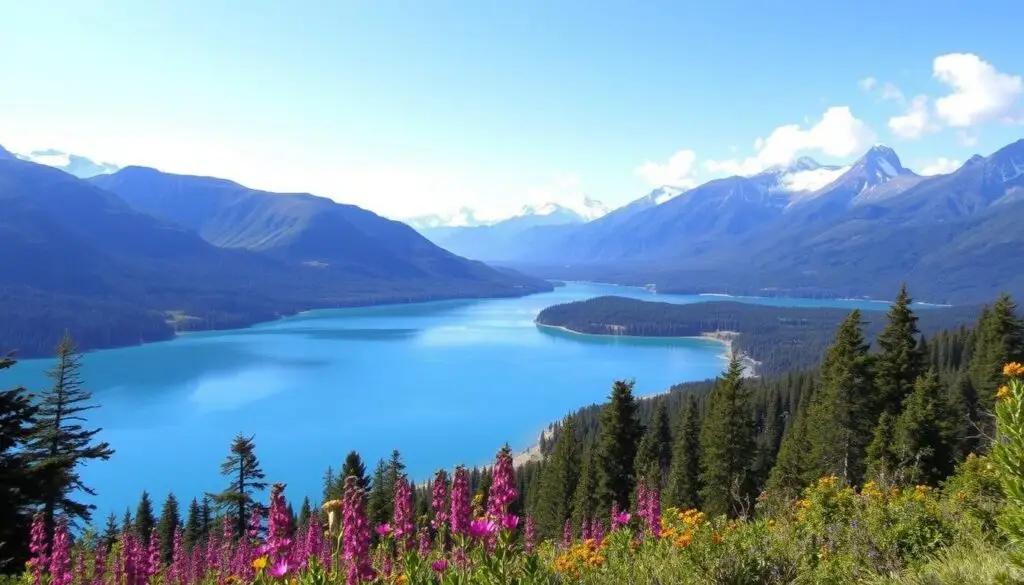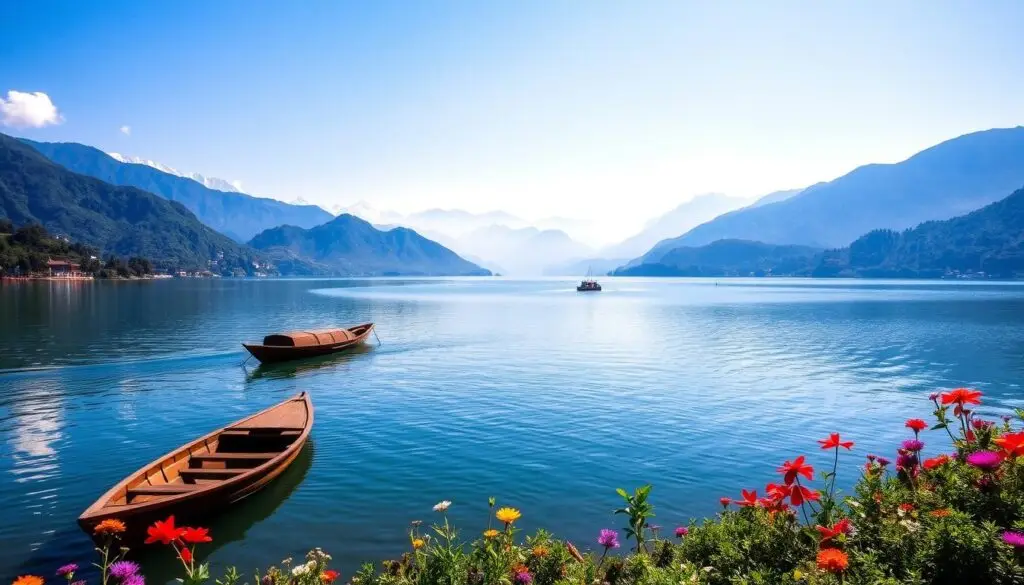I love traveling and exploring the Himalayas. Nepal’s lakes are especially captivating. From Rara Lake in the west to Phewa Lake in Pokhara, they show Nepal’s beauty and culture.
In this guide, we’ll explore three amazing lakes: Rara, Phewa, and Begnas. Each lake has its own charm. They offer stunning views, rich traditions, and diverse wildlife. This guide is perfect for anyone planning a trip to Nepal’s lakes.
Key Takeaways
- Discover the cultural significance and geographical distribution of Nepal’s major lakes
- Explore the crown jewel of western Nepal, Rara Lake, and learn about its unique wildlife and flora
- Experience the heart of Pokhara at Phewa Lake, a hub for outdoor adventures
- Unwind at the peaceful Begnas Lake, known for its local culture and stunning viewpoints
- Gain practical tips for planning your lake adventure, including essential gear, transportation, and safety considerations
Introduction to Lakes in Nepal
Nepal is home to stunning lakes nestled in the Himalayas. These lakes are sacred in Nepalese culture. They range from high-altitude lakes to peaceful ones across the country. They show the deep bond between the Nepalese people and nature.
The Sacred Role of Lakes in Nepalese Culture
Lakes in Nepal are seen as sacred. They are linked to Hindu and Buddhist gods. People hold rituals and ceremonies here, seeing the lakes as places of divine energy and purification.
Geographical Distribution of Nepal’s Major Lakes
Nepal’s lakes are spread across the country. Most are in the west and center. High-altitude lakes like Rara and Phoksundo are in the Himalayas. Lower lakes, like Phewa and Begnas, are in valleys. This shows Nepal’s varied landscapes and rich biodiversity.
Best Times to Visit Nepal’s Lakes
The best time to see Nepal’s lakes changes with the season and location. The monsoon, from June to September, makes high-altitude lakes hard to reach. But it’s great for seeing green landscapes and colorful plants. The dry season from October to May offers clearer skies and better views.
| Lake | Elevation (meters) | Best Time to Visit |
|---|---|---|
| Rara Lake | 2,990 | October to May |
| Phewa Lake | 742 | October to May |
| Begnas Lake | 650 | October to May |
Nepal’s lakes offer a unique experience, whether you prefer high-altitude, urban, or rural lakes. Knowing their cultural importance, where they are, and when to visit helps you enjoy their beauty and spiritual essence fully.
Rara Lake: The Crown Jewel of Western Nepal
In the remote Mugu district of western Nepal, there’s a stunning Rara Lake. It’s called the “Crown Jewel” of this area. This serene alpine lake shows the natural beauty of Nepal.
How to Reach Rara Lake
Getting to Rara Lake is a bit of a challenge, but it’s worth it. It sits at 10,500 feet (3,200 meters) above sea level. You can trek there from Jumla, a 3-4 day journey through beautiful landscapes.
Accommodation Options Around Rara
Though Rara Lake is far from cities, there are places to stay. You can find lodges and guesthouses in nearby villages. They offer cozy rooms and a chance to experience local life. Camping is also an option for those who love adventure.
Wildlife and Flora at Rara Lake
Rara National Park is famous for its wildlife and plants. At Rara Lake, you might see Himalayan black bears, Himalayan blue sheep, and Musk deer. The lake’s shores have many plants, like blue Himalayan poppies and rhododendron forests.

“Rara Lake is a true gem, a haven of tranquility nestled amidst the towering peaks of western Nepal. Its pristine waters and rich biodiversity make it a must-visit destination for any nature enthusiast.”
- Rara National Park
- Trekking routes
- Biodiversity
- Mugu district
Phewa Lake: The Heart of Pokhara
Phewa Lake is in the Pokhara Valley and is Nepal’s second-largest lake. It’s a beautiful spot that has attracted visitors for years. It’s a key place to see in the Nepalese countryside.
Boating on Phewa Lake is a big attraction. You can rent a boat and row, enjoying views of the Annapurna range. The Tal Barahi Temple on an island in the lake is also a favorite spot for many.
Phewa Lake isn’t just for boating. It’s also famous for paragliding. Many offer tandem flights over the lake and valley. These flights give a special view of the area’s beauty.
“Phewa Lake is a true oasis in the heart of Nepal’s stunning landscapes. It’s a place where you can find tranquility, adventure, and a deep connection to the country’s rich cultural heritage.”
Phewa Lake is a must-see in the Pokhara Valley. It offers peace, cultural sites, and exciting activities. Its beauty and role in Nepalese culture make it unforgettable.

Begnas Lake: A Peaceful Retreat
Begnas Lake is hidden in the green hills of central Nepal. It’s a calm escape from city life. The lake is surrounded by the Annapurna range, making it a top spot for a quiet rural getaway.
Activities at Begnas Lake
The lake’s calm waters are perfect for many activities. Fishing is a favorite, with people hoping to catch local fish. For thrill-seekers, kayaking offers a special view of the lake and its surroundings.
Local Culture and Communities
Begnas Lake is also a center of local culture and community. Visitors can see the daily life of nearby villages. They can experience Nepalese hospitality and learn about the area’s heritage. Talking to local artisans and craftspeople is a great way to understand the rural tourism scene.
Best Viewpoints Around Begnas
Begnas Lake has many stunning viewpoints. Hike to the nearby hills for amazing views of the lake and the Annapurna range. These spots are perfect for taking photos and finding peace.
“Begnas Lake is a true gem, offering a peaceful escape from the outside world. It’s a place where you can immerse yourself in the local culture, explore the stunning natural surroundings, and simply reconnect with nature.”
Conservation and Environmental Challenges
Exploring Nepal’s lakes is breathtaking, but they face big environmental issues. Climate change, pollution, and too much tourism are threats. We must act fast to save them for the future.
Climate change is real. It’s causing glaciers to melt, changing water levels, and harming ecosystems. This affects plants and animals, like the Himalayan brown bear and water birds.
Pollution is a big problem too. Waste and too many visitors are filling these areas with plastic. This harms the beauty and life in the water.
- We need to travel better. This means fewer visitors, eco-friendly places, and learning how to be kind to nature.
- Local groups and the government are working hard to protect these lakes. They’re cleaning up and creating safe areas.
As a visitor, I can help. I can choose green travel, think about my actions, and support local efforts. This helps keep Nepal’s lakes safe.
| Environmental Challenge | Impact on Nepal’s Lakes | Potential Solutions |
|---|---|---|
| Climate Change | Retreating glaciers, fluctuating water levels, disrupted ecosystems | Promoting renewable energy and implementing sustainable water management practices |
| Pollution | Plastic waste accumulation, harm to aquatic life | Improving waste management systems, banning single-use plastics, and educating visitors |
| Unsustainable Tourism | Overcrowding, habitat degradation, and disruption of local communities | Implementing visitor limits, promoting eco-tourism, and engaging local stakeholders |
By tackling these issues, we can keep Nepal’s lakes beautiful for the future. It’s our duty to protect these amazing places.
“The lakes of Nepal are not just natural wonders, but living, breathing ecosystems that sustain countless forms of life. We must do everything in our power to protect them.”
Planning Your Lake Adventure: Practical Tips
Getting ready for your trip to Nepal’s lakes is key. You’ll want to pack right, know how to get around, and stay safe. This guide will help you prepare for a great lake adventure.
Essential Gear and Equipment
Packing the right gear is crucial for enjoying Nepal’s lakes. Make sure you have good hiking boots, clothes that keep you dry, and something to keep you dry in the rain. Don’t forget sunscreen, a hat, and sunglasses to protect your eyes from the sun.
Trekking poles can be very helpful. They make it easier to walk on uneven paths around the lakes.
Local Transportation Options
Getting to the lakes can be an adventure. You might want to hire a local guide or get private transport for comfort. Public buses and shared taxis are options too, but the roads can be tough and travel long.
For shorter trips, think about using local boats or renting bikes. They let you explore the lakes and their surroundings easily.
Safety Considerations
Traveling at high altitudes and near water needs extra care. Watch out for altitude sickness and get travel insurance for emergencies. A local guide can be very helpful, offering insights and keeping you safe.
Also, learn about the permits and rules you need to follow. This ensures you respect the local environment and follow the law.
FAQ
What are the key features and cultural significance of Nepal’s major lakes?
Nepal’s lakes, like Rara, Phewa, and Begnas, are vital to the country’s culture and nature. These high-altitude lakes are sacred, with deep beliefs and traditions. They are also known for their stunning beauty and diverse wildlife.
How can I best prepare for a visit to Nepal’s lakes?
To enjoy Nepal’s lakes, pack the right gear and know how to get around. Be aware of altitude sickness and consider local guides. They can make your trip better and help you explore.
What are the top attractions and activities to enjoy around Rara Lake?
Rara Lake in western Nepal is famous for its calm beauty and wildlife. You can explore Rara National Park, see different plants and animals, and learn about local culture. Trekking and staying in the area make it even more special.
Why is Phewa Lake considered the heart of Pokhara?
Phewa Lake, Nepal’s second-largest, is a key spot in Pokhara Valley. Its beauty, with the Annapurna range behind, attracts boating, fishing, and paragliding. The Tal Barahi Temple on an island is also culturally important.
What makes Begnas Lake a unique and peaceful retreat?
Begnas Lake, near Pokhara, is quieter and more rural than others. You can meet locals, see the countryside, and try fishing or kayaking. Its views of the Annapurna range make it perfect for a calm, real Nepalese experience.
How can I contribute to the conservation of Nepal’s lake ecosystems?
Nepal’s lakes face challenges like climate change and pollution. Responsible tourism can help protect them. By supporting green practices, reducing carbon, and joining local conservation, you can help preserve these natural treasures for the future.


